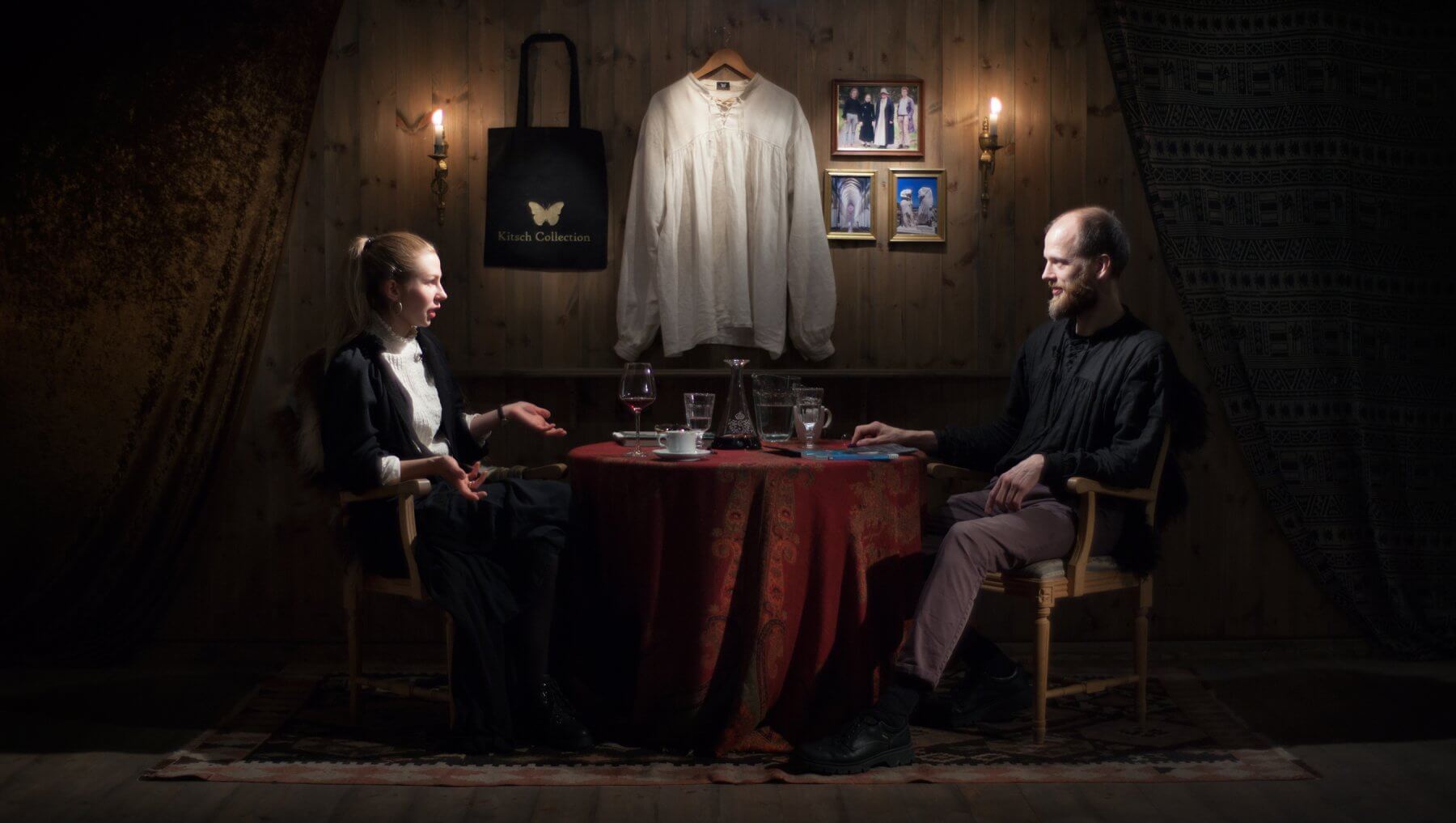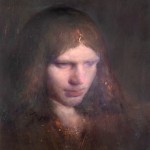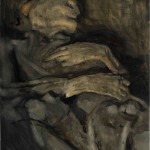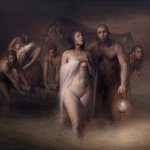News and Articles › Cave of Apelles
Kitsch… a bluff that seeks to bluff the heart, producing tears like an onion.
— Fritz Karpfen, author
Top list
View the entire list
This month, The Cave of Apelles has invited the designer Eline Dragesund, who is currently working on her new Kitsch Collection. She is no friend of consumerism and disregards fashion.
Her goal is to elevate man.
Dragesund says that her Kitsch Collection is meant as an alternative to men’s lack of variated and elegant clothes in the modern era:
– The guidelines for the brand are the same as for kitsch painters: good craft, good quality, a toned down and harmonized pallet, and a timeless mark.
<
Would you like to be credited as a supporter in future videos?
Become a patron
The Message of the Form
The collection started out with linen shirts with large sleeves, commissioned by kitsch painters. Dragesund wanted to take it further. She is soon launching several collections produced in limited editions, each based on a kitsch-person.
The inspiration for Dragesund’s first collection is Edvard Munch. But not only from his person or wardrobe. She takes her main inspiration from his early work — his palette and the way he painted clothes — trying to find the essence in his painting and adopt that into design.
– I think it is more interesting as a designer to see how he paints clothes because he stylized them. Most painters do that because they do not know how clothes are sewn together, says Dragesund.
– If you make the clothes a little more archetypical, you are left with an essence of the clothes, the message of the form, and that will last longer in their expression.
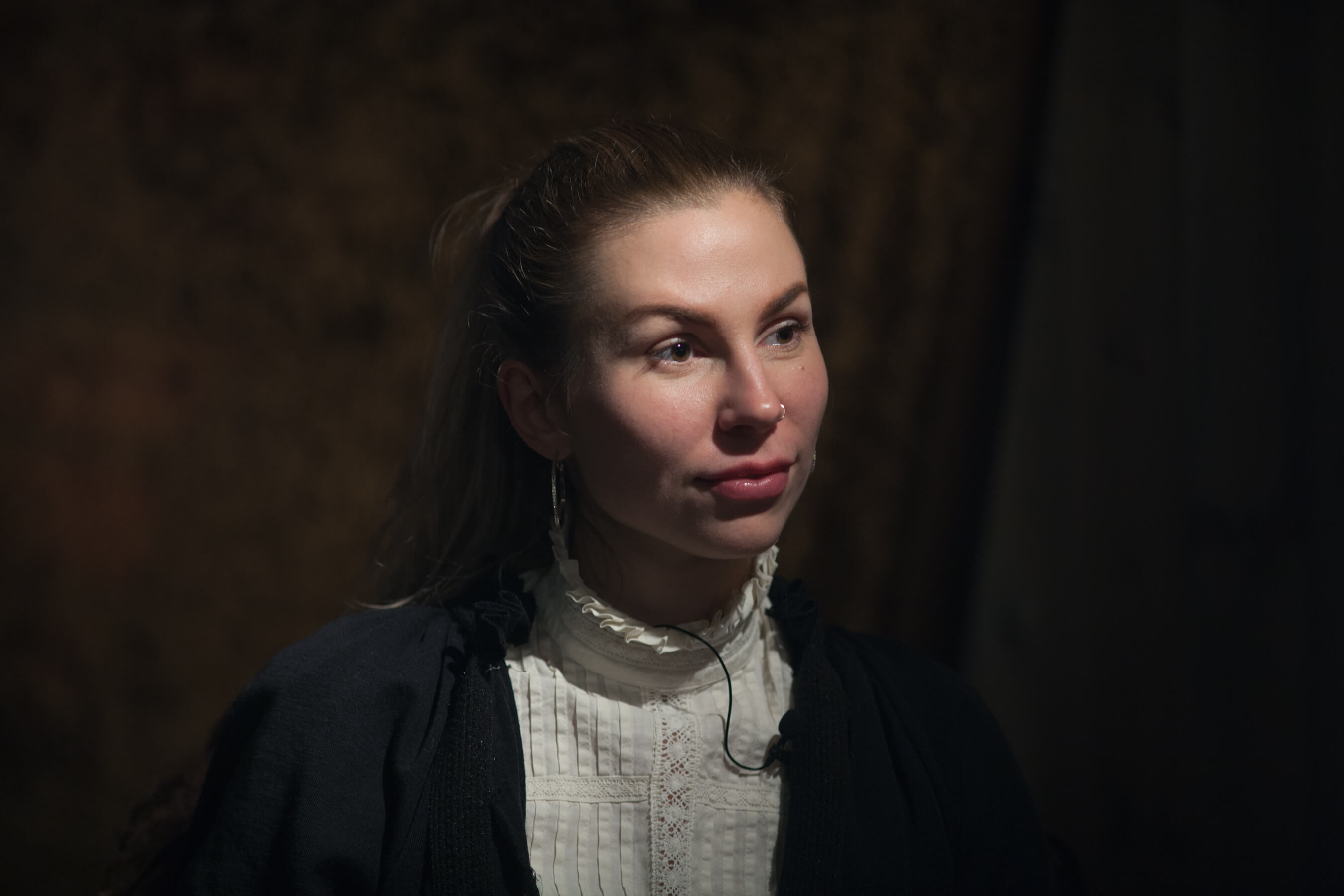
Eline Dragesund appeared on the Cave in a self-made jacket and a 100-year old blouse.
Odd Nerdrum and Kitsch
A few years ago, Dragesund was introduced to the kitsch way of thinking after meeting with Odd Nerdrum.
– There was a lot of inspiration everywhere, in paintings, books, music. It was like a classical dimension that I could drown myself in.
She was inspired by seeing Nerdrum paint enormous paintings accompanied by loud, classical music. She wanted to know and learn more.
For her, the meeting was a culture shock, especially because Nerdrum’s school was in direct opposition to the education she had received at the Design Academy. There, she explains, the students were not supposed to use past sources.
– [At the Design Academy] It is strictly forbidden to make anything that looks like something someone else has done before you. I have a lot of ideas, so I don’t want to copy anyone, but I think it should be okay to be inspired by each other. That’s how it works. We are imitation based beings, even kids imitate their parents all the time to learn, Dragesund explains.
She says she loves to see how Odd Nerdrum paints clothes. Looking through his body of work, she found a pattern.
In the beginning, she says, his subjects were dressed in actual clothes. Gradually, the clothes have dissolved. Now, she says, the characters in Nerdrum’s paintings look like men dressing for the first time in history.
Previously on the Cave of Apelles: How the State Established Fine Art
Different Disciplines, Same Technique
Jan-Ove Tuv and Eline Dragesund discuss the many similarities — in the technique and the way of thinking — between different disciplines. He is a painter, she is a designer. But both stay away from strong colors.
– I think [strong colors] steal too much attention, first of all. The designs shouldn’t need strong colors. Strong colors go in and out of fashion, explains Dragesund.
Tuv points out a similarity in painting by referencing Masaccio’s use of fairly similar colors when painting both clothes and skin. He did not want to “cut up” the body in separate parts, says Tuv.
Dragesund wants to talk about something much older than Masaccio. She is inspired by ancient Greek sculptures. When looking at sculptures, she explains, she can see that there is a depth in the draperies.
– That can also give me a link that I can use [to decide] which type of material I’m choosing in my designs. If I want something with a strong effect in my draperies, I can use silk, because silk absorbs light where it hits, and where there’s no light it’s dark.
Both kitsch painters and kitsch designers spend time on working out the composition, as a way of making the viewers see what you want them to see.
– You can compose an expression on the body. It depends on how the body looks, but you can manipulate the body a lot with thinking composition on the body, says Dragesund.
Another technique Dragesund (as a designer) and Tuv (as a painter) have in common is the practice of squinting. Dragesund now looks at pictures of clothing design through history while squinting in order to see the basic shape. Are there any shapes repeating themselves through history, she asks herself. And there definitely are.
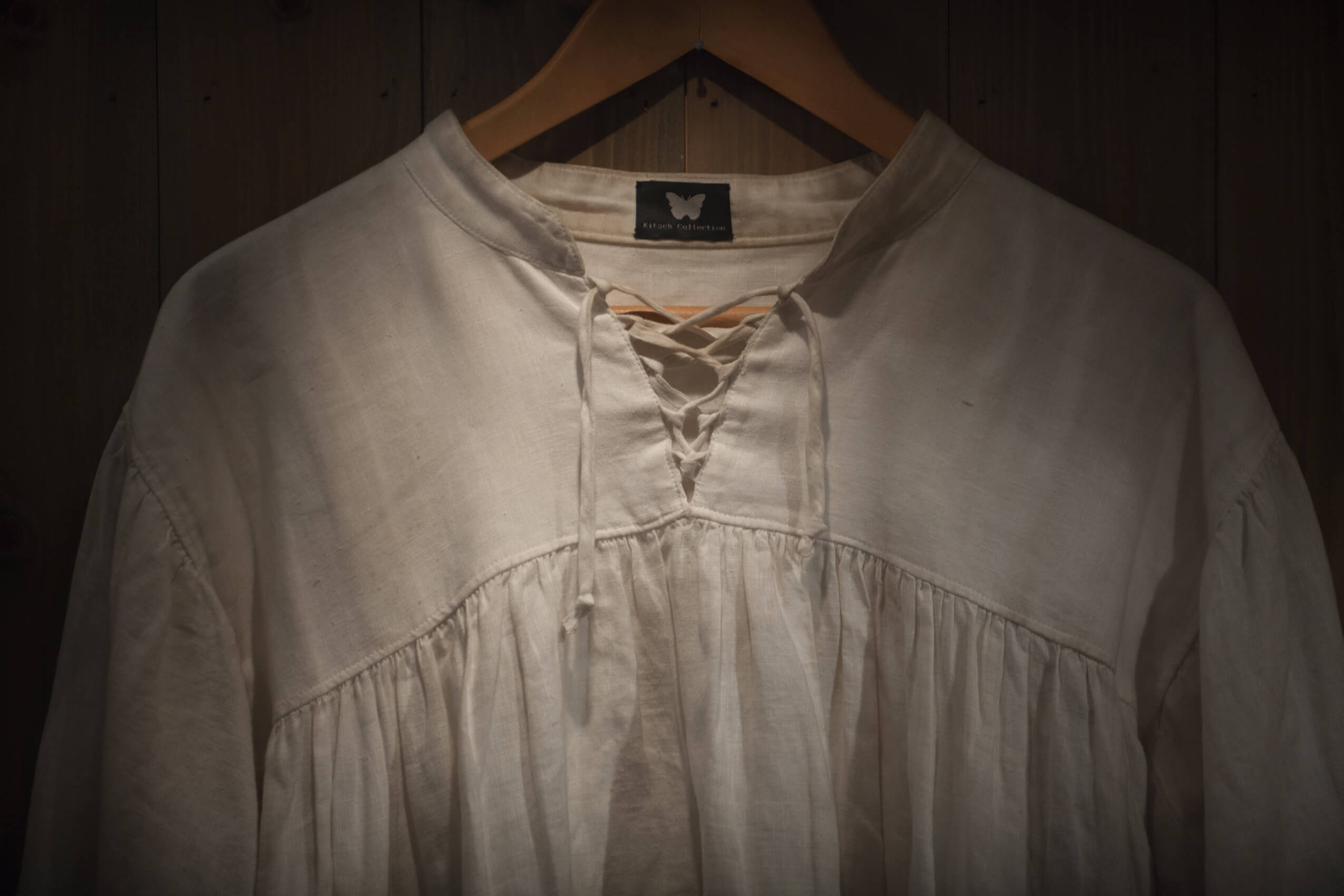
The Nerdrum Shirt by Eline Dragesund
Making a Person Into a Temple
– I am convinced that if you look at architecture, you can see some lines that remind you of the wholy, says Dragesund while pointing to a picture of the inside of a cathedral, with tall columns and a ceiling stretching towards the Heaven.
She explains how people in Medieval times or ancient Greece used lots of long silhouettes; they adopted the looks of temples and churches, and used it in clothing design to create an uplifted expression.
– Architecture and fashion go hand in hand all the time, they mirror each other.
– Especially in ancient Greece, the fashion was inspired by temples. Even the head pieces were inspired by the tops of the temples, says Dragesund, pointing to the diadems.
– That’s amazing! So you make each person into a temple, exclaims Tuv.
– Yes, that’s what they did. It’s gracious, she responds.
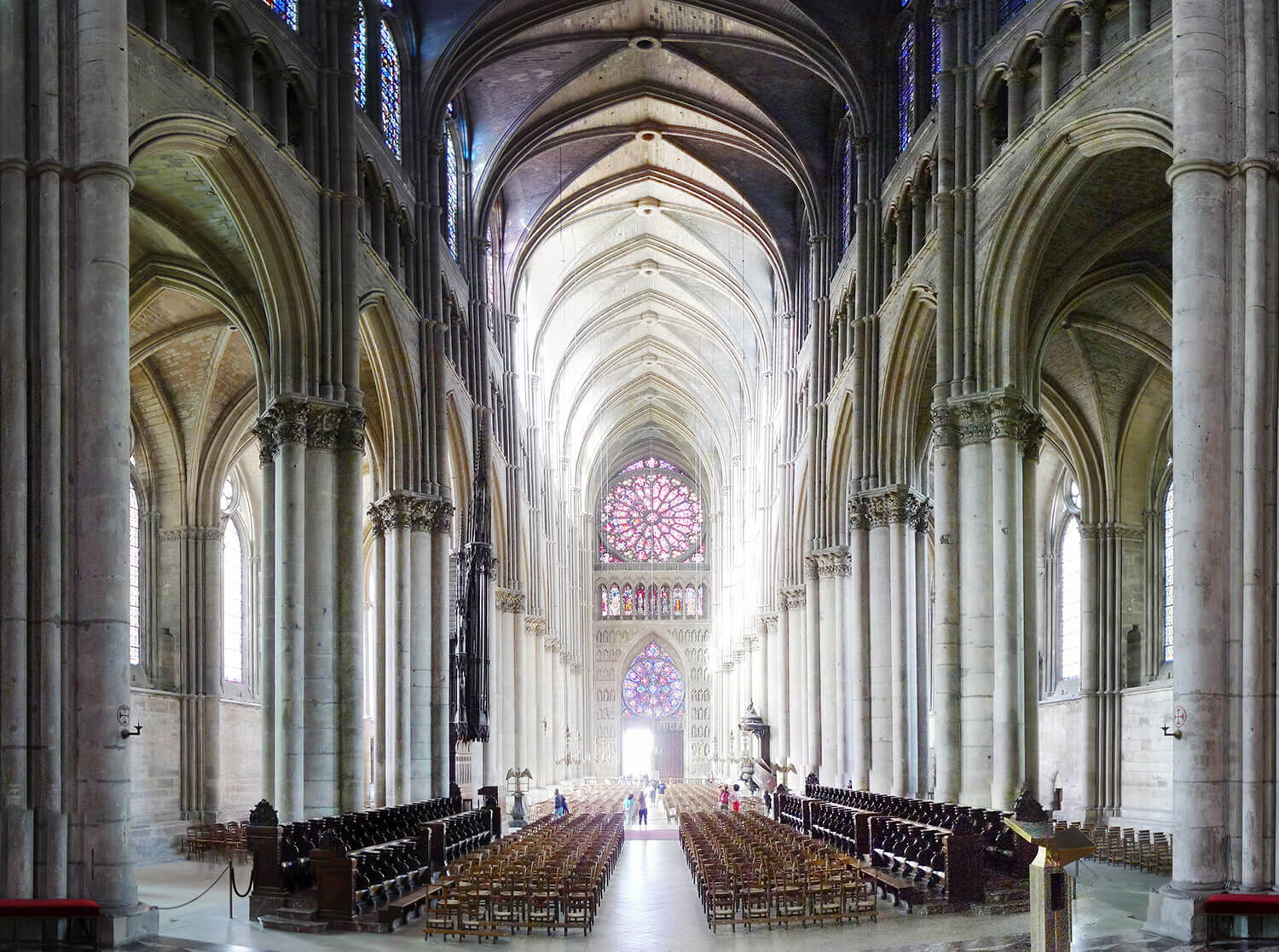
The Reims cathedral is one of the sources of inspiration for Dragesund’s design.
Clothes for Men Only
The Kitsch Collection focuses on men’s clothing. Why is this the case, Tuv asks her.
Dragesund has a distaste for the attitude of wearing clothes for the sake of following fashion. By consequence of fashion, she says, the clothes are thrown away, often unused.
The throw-away lifestyle mostly concerns women, Dragesund claims. When she worked at a recycling factory for vintage clothes, she saw that more than 70 percent of the clothes the factory received were from women. And if they received new clothes with the price tag still attached, 95 percent were women’s clothes.
To Dragesund, the more masculine attitude towards clothes aligns better with her ideals:
– A man knows what he wants, goes to get it, and wears it until it falls apart. Men invest in their wardrobe, instead of changing it all the time.
Classical Greek fashion
A key aspect of classical Greek fashion is that the clothes could be adjusted to oneself.
Is this why the Greeks looked more elevated, Tuv wants to know.
– Yes, in the modern way of dressing, you are forcing your body into a shape, or dis-shape, that we socially accept to be beautiful. And that shape does not fit all. A lot of people will have lower self-esteem because they do not fit in this form, says Dragesund
She thinks it is not healthy to wear something that does not fit to one’s body. Many young women hold their breath because the pants are too tight, she says.
Besides adjusting clothes to each individual, the classical Greek fashion underlined attractive forms.
– There are some forms that are more beautiful than others, which goes through history. For example the height of a woman, and the gracious expression. A woman has breasts, she has hips, and by putting the lines in the designs, that could lift these forms up. That’s an “eternal hit,” Dragesund explains.
According to Dragesund, fashion reflects what is going on in society. She gives the example of how they in the beginning wore Roman design in the Byzantine empire. Eventually, they wore more ornamentation, due to trade with the Orient.
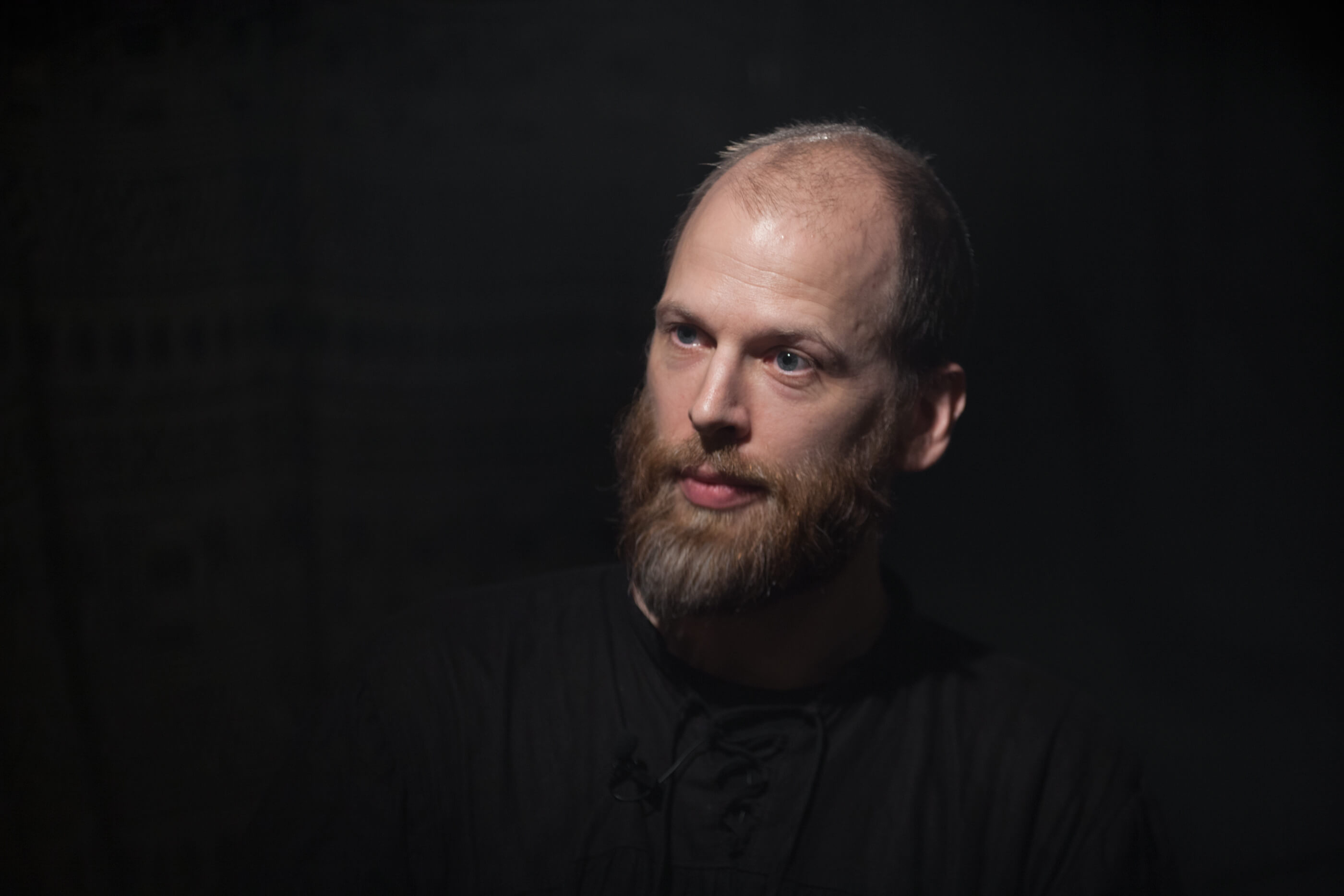
Jan-Ove Tuv, dressed in one of Dragesund’s shirts.
An Extension of Your Inner Self
Tuv moves the conversation to the topic of clothes and psyche.
– There is an old myth that says wear clothes with brighter colors, and you’ll be happier. What do you think of this saying? And why have you chosen to do the opposite, to tone down your coloring?, asks Tuv, reading a question from the audience.
Dragesund’s response is crystal clear:
– If you need more colors to brighten up your life, I would suggest: Go buy flowers!
Dragesund is passionate about the importance of being aware of one’s daily costume. She calls it “costume” because one always plays a character in life, wears a costume:
– Being aware of one’s costume, other versions of the world can be available to you.
She uses the example of being a “slump” who dresses baggy, never gets the job he wants, nor the girls he wants. If he borrows a suit, different people will look at him, people will have different expectations of him.
– What you wear and how you act is an extension of your inner life: How you see yourself, how you think, what kind of beliefs you have of the world, Dragesund says and continues:
– When you look at yourself in the mirror, especially if you are a depressed person… Well, I don’t think clothes can fix your depression, but if you buy clothes or a dress that you really think is beautiful, you should look in the mirror and absorb the beauty of yourself, and take that feeling with you: “I am beautiful”.
Clothes as Signals
Tuv points to the wisdom of the mythologist Joseph Campbell. Campbell claimed that myths let you know where you are in life. Being conscious about that transition in age could be expressed in clothing: Changing your clothes to emphasize that a transition has occurred.
Also read: What stories are worth telling?
In Roman culture, Dragesund explains, they had togas for every aspect of life. For different ages, different status, and even for different moods, such as mourning or a time of crisis.
When talking about clothes functioning as symbols, Tuv brings forth the example of Rodin’s sculpture group, The Burghers of Calais:
– Calais was seiged in the 14th century and they had to give up. The victors demand that the five most prominent people should come, dressed in rags, and deliver the key to the city, Tuv says.
By using these very heavy materials, Dragesund adds, their depression and heaviness are underlined:
– [Rodin] used clothes to underline the message. That’s something painters should be aware of.
Dragesund advises people to be aware of the signals they send out through the clothes they wear.
– Using clothes to externalize your inner values is extremely important to yourself. Because everything you do with your body and your outer looks will work as signals to the outer world, so by being aware of every signal you send out, you will receive exactly what you need and what you want, says Dragesund.
This article was first published at the Herland Report.
Published on Wednesday, January 15th, 2020
